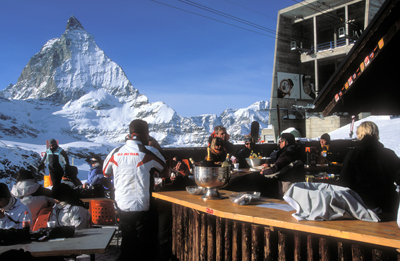 Snow sports do not combine easily with travel photography, but the environment in which they take place can be extremely photogenic. Physical conditions and access to photogenic locations may be difficult, and circumstances may be generally challenging, but there are plenty of photographic opportunities. It may be worthwhile booking a ski holiday that does not include the hire of sports equipment or lift passes, and hence taking advantage of the comparatively low-priced flights and accommodation.
Snow sports do not combine easily with travel photography, but the environment in which they take place can be extremely photogenic. Physical conditions and access to photogenic locations may be difficult, and circumstances may be generally challenging, but there are plenty of photographic opportunities. It may be worthwhile booking a ski holiday that does not include the hire of sports equipment or lift passes, and hence taking advantage of the comparatively low-priced flights and accommodation.
Skiing is the most popular winter sport, but a skier cannot easily carry more than a small compact camera. However, the extensive networks of ski lifts, cable cars and funicular railways upon which skiers depend are available to everyone and can be used to reach magnificent viewpoints that would otherwise be totally inaccessible. Marked contour-following footpaths, for which snow-shoes may be required, often lead from high-level stations through an untouched winter wonderland. The scenery can be awesome and where footpaths are crossed by ski runs there may be excellent opportunities to photograph skiers and snowboarders in action. In areas of heavy snowfall, look closely at the way virgin snow accumulates on trees, fences, roofs and so on. Simple close-ups of subjects such as these can be very effective, but take care with exposure.
When snow is the dominant element in a scene, reflected light exposure measurements are likely to result in underexpose by one or two stops. This is particularly the case in direct sunlight, so take incident readings or try metering from a standard grey card. Bracketing is a simple way of getting the optimum exposure. Contrast is very high in sunlit scenes, so try to work early or late in the day when the sun is lower, snow texture is more apparent and contrast is somewhat reduced. Ultraviolet filters should be used in the mountains to reduce the effects of ultraviolet light and haze. Polarizing filters should be used with care because blue skies may be so intense that full polarization may turn them almost black. Shadows are likely to record with a bluish cast, particularly in overcast conditions. Try using an 81A or 81B warm-up filter to eliminate this problem.
Snow cover removes detail from landscapes, reveals form and adds a graphic quality. Compositions therefore rely more heavily upon line, shape and pattern. Scenes become almost monochromatic and consequently may work well as black-and-white images. Even in overcast conditions there is likely to be plenty of light because snow is so highly reflective. Early morning after a heavy fall of snow is an ideal time to work. There will be few people or vehicles about and the snow will be largely untouched. Remember to approach subjects with care, as footprints cannot be removed.






